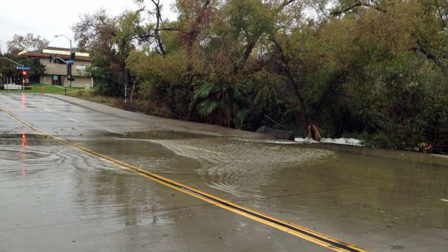State of San Diego Water
By Mike Wille, meteorologist

Mission Valley has flooded several times during 2016-2017.
California reservoirs saw a welcome turnaround in the annual winter rainy season of 2016-17, the likes of which we haven’t seen in six years. It was December 2010 where portions of the San Diego County mountains received a mega 14-plus inches of rain, challenging rivers as it raced back out to the ocean. A repeat of January is probable for at least another two months, so get ready from more rain folks.
A drought like no other that continues to parch on, despite average rainfalls flexing past 150 percent of normal thus far into the winter rainy season. Some locales of 23 feet of snow fell during that stormy January period. Numerous Sierra ski resorts were bragging about a straight three-weeks of snowfall, averaging a foot a day. So much snow, I-80 closed for two days in order for Cal Trans to rediscover pavement covered in avalanche.
The welcome precipitation was literally raining millions of dollars practically everyday in the state, saving California from a real water supply crisis. It takes years of above average precipitation to replenish a land reeling in a multi-year drought. All in large part to a series of atmospheric rivers dubbed the “Pineapple Express,” featuring 1,000s of miles of needed rain marching by way of Hawaii. A welcome five days of precipitation supplied by its sub-tropical jet, taking aim at the Bay Area, but meandering enough to Southern California to share in its wealth.
Even better to note the Sierras are coated once again, ready for more snow before cycling back into the watershed, ready to quench a growing thirst. Replenishing reservoirs, and helping restore San Joaquin’s subsiding water tables, the rains washed years of irrigation salts from once fertile soils, 2017 is ready for better crops.
Snowfall records will likely fall in February and March. The official April 1, 2017 snow measurement is predicted to tally record depths, rivaling heat-wave press conferences of a total void of snow just two years ago.
And by all accounts, seven of the state’s 12 major reservoirs are reporting above “historic averages.” The mega drought started eroding from the Northern parts of the state which finally received normal to slightly above normal rainfall for the season, silencing the empty doomsday reservoir forecasts. And it was a trend, only two years in the making…but we’ll take it!
Unfortunately, for San Diegans, most of the beneficial drought-busting rains were carried efficiently back out to sea. San Diego’s topography is very efficient in draining it’s watershed back to the sea where it essentially came from. And city officials took notice, not only by the shear visuals of river and storm water runoff that carried the areas liter built up over the years, but the massive amounts of brown water seen mixing into the surf that prompted the usual bacteria warnings to surfers.
Too quick to soak into local water tables and able to make a significant dent, city officials are discussing capturing storm water, even offering a combined $100 rebate for residents to purchased rain barrels to capture the precious rainfall, preferable to classic irrigation of area gardens. Rainwater is proven superior due to it’s distilled nature, powerful enough if raining moderately to wash irrigated salts from root bases that are known to govern and stunt growth remains.
Fortunately additional rainfall is expected to continue through the April rainy season, albeit with much above normal temperatures to help dry those soil moisture indexes back to levels requiring irrigation only 96 hours later. The good news is, 7 of 12 major California reservoirs are reporting above “historic averages” as of January 23, 2017.
Nearly 4.36 billion gallons of water fell in the City of San Diego, who consumes an average 200 million gallons of water a day, for a grand total of only 21 days supply. Increase the runoff storm water collection, and San Diego is well on its way of becoming increasingly independent in potable water supply. The historic drought has officially been improved from exceptional to severe, a large dent from the recent atmospheric river impacts.
Favored Sierra Mountain resorts reported 22.5′ (feet) of snow fall in 20 days!
Mike Wille can be followed at Twitter@WeatherWille.
Category: Featured Articles, Local News







